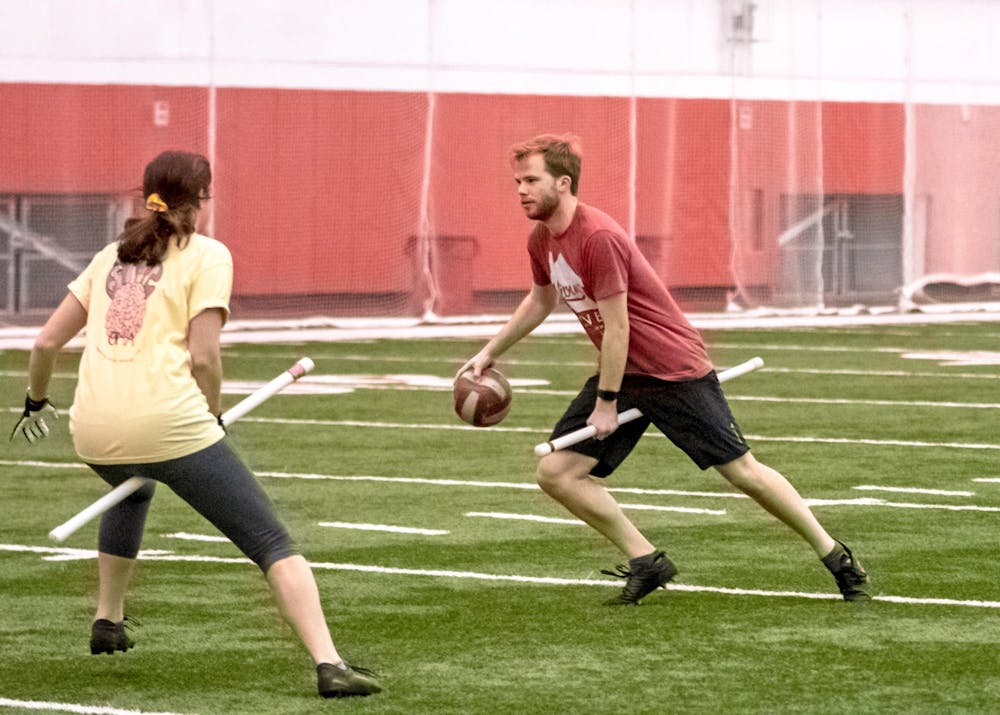Standing near one of the hoops, 5-foot-2-inch first-year Olivia Scott clutches a deflated volleyball in one hand and keeps a PVC pipe between her legs with the other. She shifts back and forth on her toes, knees bent and eyes alert.
From the left, fellow first-year Evan Baker slams into her, throwing his weight and height into the tackle as he grapples for the deflated ball.
Scott shakes him off without flinching, twisting her shoulders to protect the ball and fend off his attack. Without looking at Baker, she hurls the ball at one of his teammates, who is holding a different red-and-white striped volleyball. The opposing team member drops the ball and sprints back toward his own hoops, while Scott’s team sweeps up the fallen ball and advances.
“Good job, Olivia!” a fellow beater yells from the sidelines. On the field, play continues as Scott’s team hurtles for the hoops and scores. The head coach calls for substitutions, and Scott jogs off the field with a few others.
This isn’t soccer, or basketball or rugby. It’s Quidditch, the same sport created by J.K. Rowling in the “Harry Potter” series. While these players don’t fly or chase after winged golden balls, the magic of the sport is still captured by the mandatory broomsticks players must run with and the classic three hoops made for scoring.
This is the tenth year that Quidditch has been offered as a club sport at Miami, with players hailing from all athletic backgrounds. This year, the team comprises runners and swimmers, lacrosse and soccer players, basketball and volleyballers, dancers, mixed martial artists and cheerleaders.
Quidditch holds just a little bit of everything for everyone, and members emphasize that you need neither an athletic nor “Harry Potter” background to play.
“It’s a great way to get active in college, stay active, stay healthy, but it's also a great way to make friends,” senior head coach and chaser Jackson Cleaver said. “These are some of my closest friends here on the team and they made my college experience what it is today.”
In the actual game, teams supply seven players to the field: three chasers, two beaters, one keeper and, eventually, one seeker. Chasers work to put the quaffle, a colored volleyball, through one of three hoops while the keeper and opposing chasers defend it. The beaters handle bludgers, three dodgeballs, throwing them at players to take them temporarily out of the game. Players hit with a bludger have to drop whatever ball they’re holding, “dismount” from their brooms and run back to their hoops, touching one before they’re allowed to reenter play.
After 18 minutes, a snitch, a person wearing golden shorts, is released onto the field, a tennis ball in a sleeve velcroed to the back of their pants. Both teams’ seekers chase the snitch around the field, engaging in wrestling-like tactics to get their arms around the snitch and snatch the tennis ball. One-armed tackles are legal for seekers and others out on the field.
When first-year chaser Declan Palmer saw the Quidditch team’s table at Mega Fair, he was intrigued but skeptical. As a joke, he and his friend decided to go to the first practice last semester, and it didn’t take long for Palmer to fall in love with the sport.
“It’s one of the best decisions I’ve ever made. Part of it is the camaraderie and part of it is the competitiveness,” Palmer said. “This is one of the most tight-knit and best communities I’ve ever been a part of, and I’ve been here for not even a full year — that tells you how much time we spend together and how close we’ve been.”
Enjoy what you're reading?
Signup for our newsletter
Competitive is a word several team members used to describe Quidditch. It’s a full-contact, co-ed sport requiring mouthguards but no other protective equipment. Tryouts aren’t necessary to join the team, but Miami’s intensity and hard work has pushed them to the top of the regional and national rankings. Last year, they became the Great Lakes regional champions. This year, they ended up third in the region and it still guaranteed them a spot in nationals. Currently, Miami’s Quidditch team sits at 13th in the nation out of about 90 teams.
“In one sense, we love hanging out together and practicing together, but we also really push each other to get better, because we want to do well,” junior president and beater Matthew Sorkin said. “To be able to have that fun along with people being competitive about it is what makes me love it so much.”
Part of the reason senior chaser Katie Rauch joined Miami’s Quidditch team was the promise of physicality.
“It’s really funny because you’ll get out there and you'll play a team, and they won't expect it,” Rauch said. “Because they look at you and they see a girl, and they don’t think you’re going to tackle them, and it’s fun when you get to take them to the ground.”
Every Quidditch game requires at least two female members from each team to be on the field at any time, and Rauch emphasized that Quidditch has set a new standard for sports.
“It’s radically inclusive,” Rauch said. “It sets a model for other sports for how you can play co-ed or even just any gendered sport, because it allows you to play as the gender you identify as.”
To see Miami’s Quidditch team in action, head to Cook Field on Saturday, Feb. 22 for the team’s home tournament. Among the competition is Bowling Green State University, Cleveland State University, and the University of Michigan, who defeated Miami at regionals.
Let the games begin.




